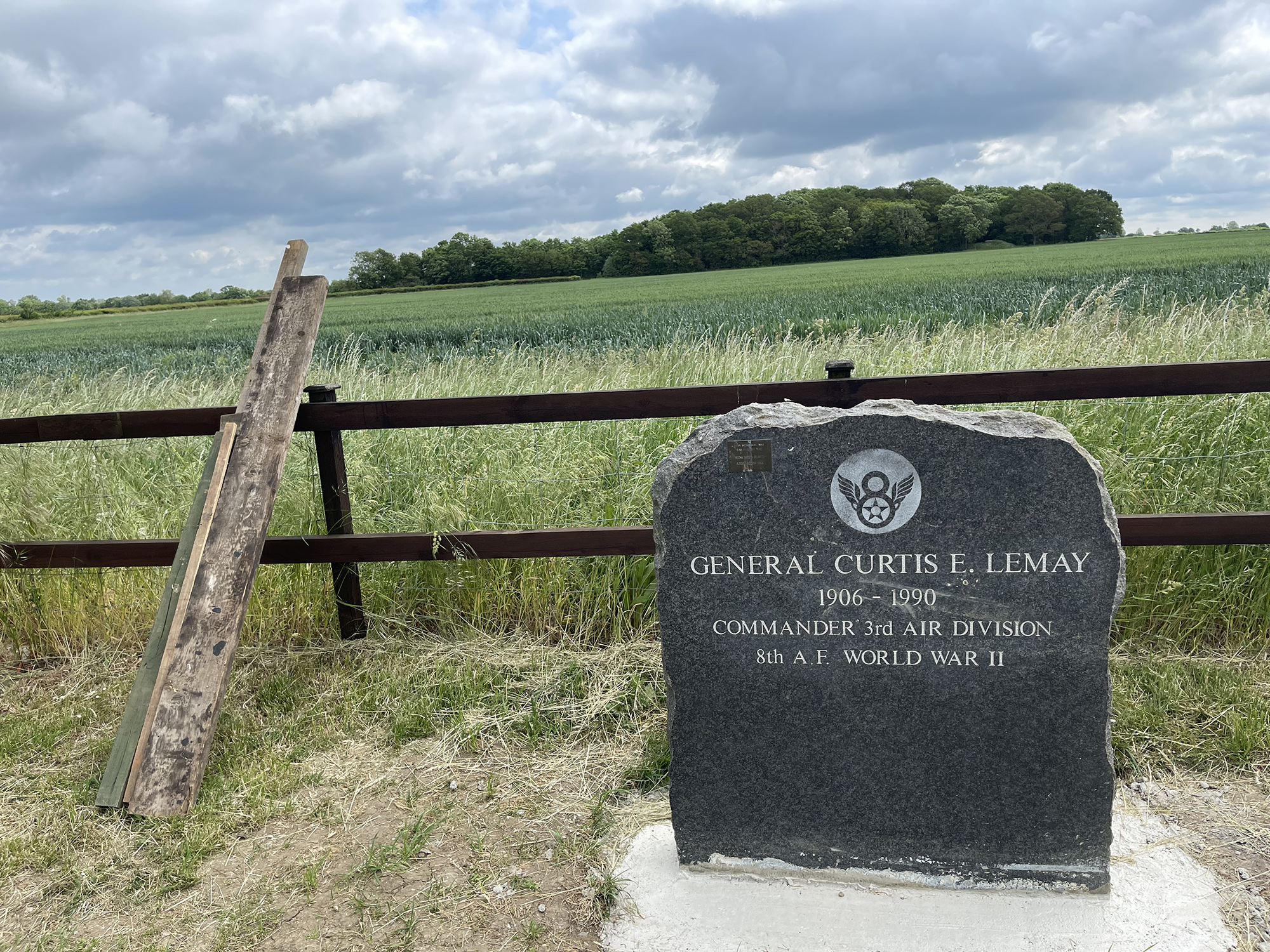You can still see the control towers and here and there a tell-tale strip of weather-beaten runway. In one church, a stained-glass window shows a B-17 bomber in flight – a remembrance of the American crews who flew from a nearby base in the heart of England and failed to return. So very many perished during the Allied bombing campaign in Europe: more than 26,000 dead from the Eighth Air Force alone – that’s more fatalities than the entire Marine Corps suffered in WWII. Of those who took to the skies to defeat Hitler before D-Day in June 1944, more than three-quarters ended up as casualties.
It’s a beautiful drive east from Cambridge through the Norfolk countryside to Thorpe Abbotts airfield, base for the legendary 100th Bomb Group of the Eighth Air Force. On a bright summer day, I walk up steps leading to the roof of the lovingly preserved control tower. I try to picture the airfield in June 1943 when the ill-fated 100th Bomb Group, which earned the nickname “Bloody Hundredth”, arrived to begin combat missions. The runways are gone, replaced by lush fields, but the view from the control tower of the vast sky remains just the same.

I imagine standing here during the war, waiting for the distant hum of a returning B-17, anxiously counting planes as they struggle home, bullet-holed and shredded by flak, after one of the 306 missions the Bloody Hundredth completed. And I think about the first of those terrible days which earned the unit its tragic nom de guerre – August 17, 1943, eighty years ago, when nine planes from twenty-one were lost during the Schweinfurt-Regensburg mission.
So many never saw England again, never got to sup another pint of warm beer in a local pub, never got to be anything but scared, homesick teenagers. 55 bombers in all were lost on 17 August 1943, double the highest previous loss for the U.S. Army Air Forces, with 552 crewmen listed as missing. A second raid on Schweinfurt in October 1943 was just as disastrous with 60 from 291 B-17s failing to return. The price was too high and such deep raids into Nazi Germany, without fighter escort, were called off for five long months.
The second raid was brought to life in a 1948 novel by Eighth Air Force veterans Sy Bartlett and Beirne Lay Jr. The novel became a superb film – my favorite about WWII – the following year: “12 O’Clock High”, starring Gregory Peck. The term “twelve o’clock high” was used by crew calling out the position of an enemy plane attacking from ahead and above.
Not far from the control tower at Thorpe Abbotts is a memorial to General Curtis E. LeMay who as a colonel led 146 B-17 bombers in the raid on Regensburg on 17 August 1943. LeMay was a famously belligerent, no-nonsense combat commander who went on to oversee air operations against the Japanese, including the firebombing of 67 Japanese cities and the atomic destruction of Hiroshima and Nagasaki. “I suppose if I had lost the war,” he later stated, “I would have been tried as a war criminal."

Half an hour’s drive from Thorpe Abbotts lies Old Buckenham airfield. There’s still a runway close to a small but wonderful museum dedicated to the 453rd Bombardment Group. I enjoy a fine cup of tea in “Jimmy’s Cafe” – named after the actor Jimmy Stewart who was group operations officer at Old Buckenham in the spring of 1944. The most evocative of the many photographs of Stewart is of him standing on a platform of the control tower, binoculars in hand, anxiously looking skyward.


By war’s end, after twenty combat missions, Stewart received two Distinguished Flying Crosses and became one of the rare few who rose from private to the rank of full colonel in just four years. Stewart’s first post-war film was 1946’s “It’s A Wonderful Life”. Nominated for an Oscar, Stewart was haunted by the losses he’d experienced in England and channeled his grief and trauma into his favorite of the eighty films he appeared in from 1935 to 1991. He retired as Brigadier General from the USAF in 1968.
My last stop is another church, this time in East Anglia. I hear doves cooing. Wildflowers dot the tall grass between graves. Young Americans came here in WWII from a nearby base, standing their bicycles nearby, and filed into the pews. Eighty years ago, the crews of the “Mighty Eighth” needed all the divine intervention they could muster. Just four lucky souls from thirty-eight co-pilots in one bomb group managed to complete twenty-five missions.

I am alone in the old church. I walk toward the altar and find a pew. I am grateful to my fellow countrymen who have preserved so much of history at old airfields, who continue to honor the immense sacrifice of U.S. flyboys, who welcome the children and grandchildren of the crews who did and did not defy such great odds to defeat Nazism from on high.
I look closely at a kneeling cushion that for some reason has caught my attention. It is embroidered with the gold and blue insignia of the mighty Eighth Air Force. I smile to myself. Eighty years on, here in Blighty, people still drop to their knees and thank God for old American friends.